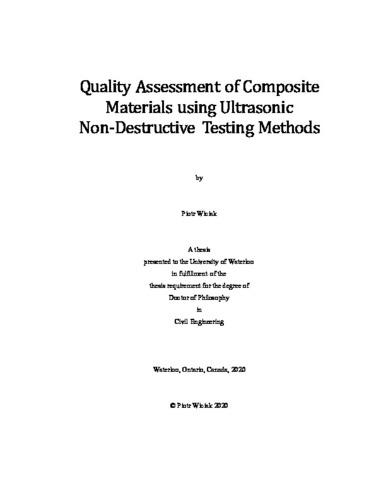| dc.description.abstract | Non-destructive ultrasonic evaluation (NDE) is commonly used for assessment of civil infrastructure
and characterization of construction materials. It is an efficient technique that could save millions of
dollars with respect to traditional intrusive tests. However, limitations regarding the use of NDE
techniques are still present.
The conventional non-destructive testing (NDT) methods (impact echo, ultrasonic pulse velocity
[UPV]) are focused on velocity; therefore, neither the frequency content of the response nor the
frequency characteristics of the transmitter signal to a tested material is usually utilized. However, it
has been shown that this can lead to misinterpretation of ultrasonic data. Even for the fairly simple
method like UPV (where the method is based on the concept of measuring the time of flight for the first
arriving ultrasonic wave from one side of the specimen to another), it has been shown that the UPV
results may be affected by many factors, such as water-cement ratio, aggregate size, or distribution of
moisture. Additionally, traditional wave velocity-based methods are not sufficient for early damage
detection (which is an active research field in the non-destructive testing of civil infrastructure) as they
use only one data point of information, neglecting the frequency content of ultrasonic signals. Finally,
the long-term durability of glass-FRP (GFRP) in concrete remains an unresolved issue. The necessity
of reliable NDE techniques for GFRP bars is even more important for in-situ testing of concrete
members with GFRP reinforcement because the bars embedded in concrete show no visual
deterioration and cannot be cut out of a structure to test in a traditional way.
The main objective of this research is to enhance the understanding of the frequency effects on
ultrasonic measurements and establish a comprehensive methodology for early damage detection of
composite materials (based on wave velocity, attenuation, and dispersion). This research consists of
four studies.
First, a characterization procedure is developed, using a state-of-the-art laser Doppler vibrometer, to
understand the frequency content transmitted by ultrasonic transducers typically used in civil
engineering applications.
Second, a group of concrete specimens of different diameter and length is tested with a traditional
ultrasonic pulse velocity method (using ultrasonic transducers with different resonant frequencies and
the laser vibrometer) to evaluate how the frequency content of the recorded ultrasonic measurements
changes with different resonant frequency transducers and how it depends on specimen dimensions.vi
Third, a new methodology, based on wavelet synchrosqueezed transform (WSST) and both velocity
and attenuation approaches, is developed to address an issue of early damage detection in cementitious
materials (i.e. concrete elements and cemented sand specimen). The proposed framework is verified
with synthetic signals and two real, lab-scale applications.
Finally, the functionality of the newly developed ultrasonic procedure (i.e. based on characterized
ultrasonic transducers, the WSST, and velocity and attenuation approach) is investigated on progressive
damage of glass fibre reinforced polymer specimens. The ultrasonic evaluation is verified with the
traditional destructive test (i.e. shear test) and numerical simulations.
The characterization procedure, developed for ultrasonic transducers typically used in civil
engineering applications, reveals that frequency content, transmitted by the transducers to the tested
medium, consists of more than just transducer resonant frequency. The importance of using well-characterized ultrasonic transducers (i.e. including the full frequency content in the NDT evaluation) is
demonstrated on the ultrasonic evaluation of concrete elements, cemented sand specimen, and GFRP
reinforcing bars. The study of frequency effects is continued with concrete cylinders of different
dimensions. Therefore, practical recommendations regarding the minimum specimen length, effects of
increasing length and diameter, and limitations regarding the use of high frequencies in the ultrasonic
evaluation of concrete elements are given. Next, a framework based on wave velocity and attenuation
(including a demonstration of the advantages of applying the wavelet synchrosqueezed transform
[WSST]) is proposed for the evaluation of distributed damage (i.e. early damage induced by freeze and
thaw cycles in concrete elements) and localized damage (i.e. cemented sand specimen with a subsurface
void). The results indicate that the WSST technique has the potential to improve both the detection of
distributed damage by up to 52% and localized damage detection by up to 36%. Finally, a progressive
deterioration of GFRP reinforcing bars is studied using the developed ultrasonic procedure. The
comparison of ultrasonic evaluation based on wave amplitude, destructive shear test, and numerical
simulations shows that ultrasonic techniques can successfully predict the degradation of shear strength
(and ultimately tensile strength) of GFRP bars (with the maximum error of 7%). The findings presented
in this thesis provide practical recommendations and frameworks that can successfully increase the
reliability of non-destructive ultrasonic evaluation of composite materials used in civil engineering
app | en |

